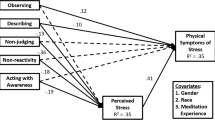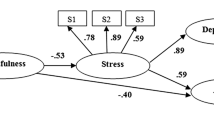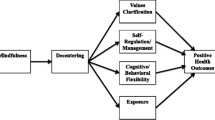Abstract
This study examined the potential stress-buffering role of mindfulness (including dimensions of observing, describing, acting with awareness, non-judging, and non-reactivity) in the relationship between perceived stress and psychological adjustment (i.e., depression, anxiety, life satisfaction, and dimensions of psychological well-being) in university students. A total of 481 Australian law students completed an online questionnaire. Hierarchical multiple regression analyses indicated that higher levels of mindfulness were related to improved adjustment on all outcomes. In support of predictions, dispositional mindfulness buffered the effects of perceived stress on depression and anxiety. Further analyses indicated that the ability to describe experience was particularly important in mitigating the effects of stress on depression and anxiety, as was the ability to observe internal and external experiences in mitigating the effects of stress on depression and reduced life satisfaction. Interventions to increase mindfulness, including specific facets of mindfulness, are proposed as a method of protecting the psychological well-being of students confronted with university stressors.


Similar content being viewed by others
References
Aiken, L. S., & West, S. G. (1991). Multiple regression: testing and interpreting interactions. Newbury Park: Sage.
American College Health Association. (2014). American College Health Association—National College Health Assessment II: reference group executive summary report spring 2014. Hanover, MD: Author.
Baer, R. (2009). Self-focused attention and mechanisms of change in mindfulness-based treatment. Cognitive Behaviour Therapy, 38(1), 15–20. doi:10.1080/16506070902980703.
Baer, R. A., Carmody, J., & Hunsinger, M. (2012). Weekly change in mindfulness and perceived stress in a mindfulness-based stress reduction program. Journal of Clinical Psychology, 68(7), 755–765. doi:10.1002/jclp.21865.
Baer, R. A., Smith, G. T., Hopkins, J., Krietemeyer, J., & Toney, L. (2006). Using self-report assessment methods to explore facets of mindfulness. Assessment, 13(1), 27–45. doi:10.1177/1073191105283504.
Baer, R. A., Smith, G. T., Lykins, E., Button, D., Krietemeyer, J., Sauer, S., Walsh, E., Duggan, D., & Williams, J. M. G. (2008). Construct validity of the Five Facet Mindfulness Questionnaire in meditating and nonmeditating samples. Assessment, 15(3), 329–342. doi:10.1177/1073191107312003.
Behar, E., McGowan, S. K., McGlaughlin, K. A., Borkovec, T. D., Goldwin, M., & Bjorkquist, O. (2012). Concreteness of positive, negative, and neutral repetitive thinking about the future. Behavior Therapy, 43, 300–312. doi:10.1016/j.beth.2011.07.002.
Bergin, A., & Pakenham, K. (2014). Law student stress: relationships between academic demands, social isolation, career pressure, study/life imbalance and adjustment outcomes in law students. Psychiatry, Psychology and Law, 22(3), 388–406. doi:10.1080/13218719.2014.960026.
Bränström, R., Duncan, L. G., & Moskowitz, J. T. (2011). The association between dispositional mindfulness, psychological well-being, and perceived health in a Swedish population-based sample. British Journal of Health Psychology, 16, 300–316. doi:10.1348/135910710X501683.
Brown, K. W., & Ryan, R. M. (2003). The benefits of being present: mindfulness and its role in psychological well-being. Journal of Personality and Social Psychology, 84(4), 822–848. doi:10.1037/0022-3514.84.4.822.
Brown, K. W., Ryan, R. M., & David, C. J. (2007). Mindfulness: theoretical foundations and evidence for its salutary effects. Psychological Inquiry, 18(4), 211–237. doi:10.1080/10478400701598298.
Brown, K. W., Weinstein, N., & Creswell, J. D. (2012). Trait mindfulness moderates neuroendocrine and affective responses to social evaluative threat. Psychoneuroendocrinology, 37, 2037–2041. doi:10.1016/j.psyneuen.2012.04.003.
Carlson, L. E., & Brown, K. W. (2005). Validation of the Mindful Attention Awareness Scale in a cancer population. Journal of Psychosomatic Research, 58(1), 29–33. doi:10.1016/j.psychores.2004.04.366.
Carmody, J., & Baer, R. A. (2008). Relationships between mindfulness practice and levels of mindfulness, medical and psychological symptoms and well-being in a mindfulness-based stress reduction program. Journal of Behavioral Medicine, 31(1), 23–33. doi:10.1007/s10865-007-9130-7.
Carmody, J., Baer, R. A., Lykins, E. L. B., & Olendzki, N. (2009). An empirical study of the mechanisms of mindfulness in a mindfulness-based stress reduction program. Journal of Clinical Psychology, 65(6), 613–626. doi:10.1002/jclp.20579.
Carver, C. S., Scheier, M. F., & Segerstrom, S. C. (2010). Optimism. Clinical Psychology Review, 30, 879–889. doi:10.1016/j.cpr.2010.01.006.
Cash, M., & Whittingham, K. (2010). What facets of mindfulness contribute to psychological well-being and depressive, anxious, and stress-related symptomatology? Mindfulness, 1, 177–182. doi:10.1007/s12671-010-0023-4.
Ciesla, J. A., Reilly, L. C., Dickson, K. S., Emanuel, A. S., & Updegraff, J. A. (2012). Dispositional mindfulness moderates the effects of stress among adolescents: rumination as a mediator. Journal of Clinical Child and Adolescent Psychology, 53, 41(6), 760–770. doi:10.1080/15374416.2012.698724.
Cohen, S., Karmarck, T., & Mermelstein, R. (1983). A global measure of perceived stress. Journal of Health and Social Behavior, 24(4), 385–396. doi:10.2307/2136404.
Creswell, J. D., & Lindsay, E. K. (2014). How does mindfulness training affect health? A mindfulness buffering account. Current Directions in Psychological Science, 23(6), 401–407. doi:10.1177/0963721414547415.
Cronbach, L. J. (1951). Coefficient alpha and the internal structure of tests. Psychometrika, 16(3), 297–334. doi:10.1007/BF02310555.
Desrosiers, A., Klemanski, D. H., & Nolen-Hoeksema, S. (2013). Mapping mindfulness facets onto dimensions of anxiety and depression. Behavior Therapy, 44, 373–384. doi:10.1016/j.beth.2013.02.001.
Diener, E., Emmons, R. A., Larsen, R. J., & Griffin, S. (1985). The satisfaction with life scale. Journal of Personality Assessment, 49(1), 71–75. doi:10.1207/s15327752jpa4901_13.
Dyson, R., & Renk, K. (2006). Freshmen adaption to university life: depressive symptoms, stress, and coping. Journal of Clinical Psychology, 62, 1231–1244. doi:10.1002/jclp.20295.
Ehlers, A., & Breuer, P. (1996). How good are patients with panic disorder at perceiving their heartbeats? Biological Psychology, 42, 165–182. doi:10.1016/0301-0511(95)05153-8.
Eisenberg, D., Gollust, S. E., Golberstein, E., & Hefner, J. L. (2007). Prevalence and correlates of depression, anxiety, and suicidality among university students. The American Journal of Orthopsychiatry, 77, 534–542. doi:10.1037/0002-9432.77.4.534.
Evans, M. G. (1985). A Monte Carlo study of the effects of correlated method variance in moderated multiple regression analysis. Organizational Behavior and Human Decision Processes, 36(3), 305–323. doi:10.1016/0749-5978(85)90002-0.
Friedlander, L. J., Reid, G. J., Shupak, N., & Cribbie, R. (2007). Social support, self-esteem, and stress as predictors of adjustment to university among first-year undergraduates. Journal of College Student Development, 48(3), 259–274. doi:10.1353/csd.2007.0024.
Gatchel, R. J., & Kishino, N. D. (2012). Conceptual approaches to occupational health and wellness: an overview. In R. J. Gatchel & I. Z. Schultz (Eds.), Handbook of occupational health and wellness. New York: Springer Science and Business Media.
Gu, J., Strauss, C., Bond, R., & Cavanagh, K. (2015). How do mindfulness-based cognitive therapy and mindfulness-based stress reduction improve mental health and well-being? A systematic review and meta-analysis of meditation studies. Clinical Psychology Review, 37, 1–12. doi:10.1016/j.cpr.2015.01.006.
Halpern, C. (2012). The mindful lawyer: why contemporary lawyers are practicing meditation. Journal of Legal Education, 61(4), 641–646.
Hayes, S. C., Strosahl, K. D., & Wilson, K. G. (1999). Acceptance and commitment therapy: an experiential approach to behavior change. New York: Guilford Press.
Hirsch, J. K., & Ellis, J. B. (1996). Differences in life stress and reasons for living among college suicide ideators and non-ideators. College Student Journal, 30, 377–384.
Jaccard, J., Turrisi, R., & Wan, C. K. (1990). Interaction effects in multiple regression. Newbury Park: Sage.
Kabat-Zinn, J. (1982). An outpatient program in behavioral medicine for chronic pain patients based on the practice of mindfulness meditation: theoretical considerations and preliminary results. General Hospital Psychiatry, 4, 33–47.
Kabat-Zinn, J. (1990). Full catastrophe living: using the wisdom of your body and mind to face stress, pain and illness. New York: Delacourt.
Kabat-Zinn, J. (1994). Wherever you go, there you are. New York: Hyperion.
Kelk, N. J., Medlow, S., & Hickie, I. (2010). Distress and depression among Australian law students: incidence, attitudes and the role of universities. Sydney Law Review, 32(1), 113–122.
Khoury, B., Lecomte, T., Fortin, G., Massee, M., Therien, P., Bouchard, V., Chapleau, M. A., Paquin, K., & Hofmann, S. G. (2013). Mindfulness-based therapy: a comprehensive meta-analysis. Clinical Psychology Review, 33(6), 763–771. doi:10.1016/j.cpr.2013.05.005.
Khoury, B., Sharma, M., Rush, S. E., & Fournier, C. (2015). Mindfulness-based stress reduction for healthy individuals: a meta-analysis. Journal of Psychosomatic Research, 78, 519–528. doi:10.1016/j.jpsychores.2015.03.009.
LaMontagne, A. D., Keegel, T., Louie, A. M., & Ostry, A. (2010). Job stress as a preventable upstream determinant of common mental disorders: a review for practitioners and policy-makers. Advances in Mental Health, 9(1), 17–35. doi:10.5172/jamh.9.1.17.
Lazarus, R. S., & Folkman, S. (1984). Stress, appraisal, and coping. New York: Springer.
Linehan, M. M. (1993a). Skills training manual for treating borderline personality disorder. New York: Guilford Press.
Linehan, M. M. (1993b). Cognitive-behavioral treatment of borderline personality disorder. New York: Guilford Press.
Lovibond, S. H., & Lovibond, P. F. (1995). Manual for the Depression Anxiety Stress Scales (2nd ed.). Sydney: Psychology Foundation.
Malinowski, P., & Lim, H. J. (2015). Mindfulness at work: positive affect, hope, and optimism mediate the relationship between dispositional mindfulness, work engagement, and well-being. Mindfulness, 6(6), 1250–1262. doi:10.1007/s12671-015-0388-5.
Marks, A. D. G., Sobanski, D. J., & Hine, D. W. (2010). Do dispositional rumination and/or mindfulness moderate the relationship between life hassles and psychological dysfunction in adolescents? The Australian and New Zealand Journal of Psychiatry, 44(9), 831–838. doi:10.3109/00048674.2010.487478.
Michl, L. C., McLaughlin, K. A., Shepherd, K., & Nolen-Hoeksema, S. (2013). Rumination as a mechanism linking stressful life events to symptoms of depression and anxiety: longitudinal evidence in early adolescents and adults. Journal of Abnormal Psychology, 122(2), 339–352. doi:10.1037/a0031994.
Miczo, N., Miczo, L. A., & Johnson, M. (2006). Parental support, perceived stress, and illness related variables among first-year college students. The Journal of Family Communication, 6(2), 97–117. doi:10.1207/s15327698jfc0602_1.
Neale-Lorello, D., & Haaga, D. A. F. (2015). The “observing” facet of mindfulness moderates stress/symptom relations only among meditators. Mindfulness, 6(6), 1286–1291. doi:10.1007/s12671-015-0396-5.
Nolen-Hoeksema, S., Wisco, B. E., & Lyubomirsky, S. (2008). Rethinking rumination. Perspectives on Psychological Science, 3, 400–424. doi:10.1111/j.1745-6924.2008.00088.x.
Ramler, T. R., Tennison, L. R., Lynch, J., & Murphy, P. (2015). Mindfulness and the college transition: the efficacy of an adapted mindfulness-based stress reduction intervention in fostering adjustment among first-year students. Mindfulness, 7(1), 179–188. doi:10.1007/s12671-015-0398-3.
Riskin, L. L. (2002). The contemplative lawyer: on the potential contributions of mindfulness meditation to law students, lawyers, and their clients. Harvard Negotiation Law Review, 7(1), 66–110.
Rogers, S. (2012). The mindful law school: an integrative approach to transforming legal education. Touro Law Review, 28, 1189–1205.
Ryff, C. D., & Keyes, C. L. (1995). The structure of psychological well-being revisited. Journal of Personality and Social Psychology, 69(4), 719–727. doi:10.1037/0022-3514.69.4.719.
Salmon, P., Sephton, S., Weissbecker, I., Hoover, K., Ulmer, C., & Studts, J. L. (2004). Mindfulness meditation in clinical practice. Cognitive and Behavioral Practice, 11, 434–446. doi:10.1016/S1077-7229(04)80060-9.
Sauer, S., Walach, H., Schmidt, S., Hinterberger, T., Lynch, S., Büssing, A., & Kohls, N. (2013). Assessment of mindfulness: review on state of the art. Mindfulness, 4, 3–17. doi:10.1007/s12671-012-0122-5.
Shapiro, S. L., Brown, W. B., & Biegel, G. W. (2007). Teaching self-care to caregivers: effects of mindfulness-based stress reduction on the mental health of therapists in training. Training and Education in Professional Psychology, 1(2), 105–115. doi:10.1037/1931-3918.1.2.105.
Sheehy, R., & Horan, J. J. (2004). Effects of stress inoculation training for 1st-year law students. International Journal of Stress Management, 11(1), 41–55. doi:10.1037/1072-5245.11.1.41.
Spector, P. E. (1992). A consideration of the validity and meaning of self report measures of job conditions. In C. L. Cooper & I. T. Roberston (Eds.), International review of industrial and organizational psychology (pp. 123–151). Chichester: Wiley.
Tabachnick, B. G., & Fidell, L. S. (2007). Using multivariate statistics (5th ed.). Boston: Allyn and Bacon.
Watkins, E. R. (2008). Constructive and unconstructive repetitive thought. Psychological Bulletin, 134(2), 163–206. doi:10.1037/0033-2909.134.2.163.
Werch, C., Bian, H., Moore, M., Ames, S., DiClemente, C., & Weiler, R. (2007). Brief multiple behavior interventions in a college student health care clinic. Journal of Adolescent Health, 41(6), 577–585. doi:10.1016/j.jadohealth.2007.06.003.
Author information
Authors and Affiliations
Corresponding author
Rights and permissions
About this article
Cite this article
Bergin, A.J., Pakenham, K.I. The Stress-Buffering Role of Mindfulness in the Relationship Between Perceived Stress and Psychological Adjustment. Mindfulness 7, 928–939 (2016). https://doi.org/10.1007/s12671-016-0532-x
Published:
Issue Date:
DOI: https://doi.org/10.1007/s12671-016-0532-x




